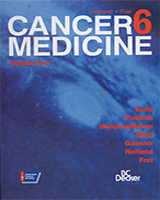By agreement with the publisher, this book is accessible by the search feature, but cannot be browsed.
NCBI Bookshelf. A service of the National Library of Medicine, National Institutes of Health.
Kufe DW, Pollock RE, Weichselbaum RR, et al., editors. Holland-Frei Cancer Medicine. 6th edition. Hamilton (ON): BC Decker; 2003.

Holland-Frei Cancer Medicine. 6th edition.
Show detailsThrough a series of well-orchestrated divisions, hematopoietic stem cells give rise to all the blood elements: mature lymphocytes, granulocytes, monocytes, erythrocytes, and megakaryocytes/ platelets. Functionally, these early progenitors are capable of self-renewal as well as proliferation and differentiation. Self-renewal occurs when a cell enters the cell cycle and undergoes one round of mitosis, giving rise to daughter cells at the same stage of development. Differentiation defines the sequence of events by which cells mature. There is a loss of self-renewal capacity as lineage commitment progresses, though some regenerative capacity may be maintained.
The development, homeostasis, trafficking, and response capacity of the hematopoietic system are tightly regulated by a complex communications network that is mediated by intercellular signals. These signals are triggered by direct cell-to-cell or cell-to-matrix contact or by the release of soluble cytokine mediators. Cytokines act on cells by interacting with specific receptors on the cell surface. This interaction promotes signal transmission across the cell membrane and activates intercellular signaling cascades that are integrated at the gene expression level. The vast majority of the soluble cytokine ligands can elicit a wide array of biologic responses. At the same time, there is considerable overlap in function between many of these cytokines.
“Hematopoietic growth factors” also serve as critical immunoregulatory molecules. Indeed, some of the most important advances in the last 10 years in our understanding of how to direct the immune response by vaccination or immunotherapy have been the description and subsequent refinement of the T helper type1/2 (Th1/2) paradigm. The defining characteristic of the Th1 and Th2 cells is that they stably express the ability to produce certain cytokines but not others. Furthermore, it is now known that pathogens shape virtually all aspects of the immune response through their interaction with cytokines.
Many of the “hematopoietic growth factors” are produced by bone marrow stromal cells, which reside in close proximity to hemopoietic precursors. In general, two or more types of cytokines are needed for each hematopoietic lineage to fulfill its developmental potential. Though many of the hematopoietic growth factors exhibit considerable functional redundancy, their biologic actions may differ in subtle but important ways. Both the redundancy and the distinctiveness of physiologic impact is explained, in part, by the swapping of common receptor subunits. For instance, cytokines may have their own private receptor but may also share a “public” receptor with other cytokines (Tables 58-1 and 58-2).
Table 58-1
Types of Hematopoietic Growth Factor Receptors.
Table 58-2
Receptor Subunits Shared Among Cytokines.
Ultimately, hematopoiesis and immunocompetence depend on a balance between stimulatory and inhibitory molecules. Indeed, many of the growth factors have suppressive counterparts which attenuate their effects. For instance, cell surface cytokine receptors often have soluble analogues generated by alternative mRNA splicing or by proteolytic cleavage of the cell surface form of the receptor. Soluble receptors function as natural antagonists by competing with the cell surface receptor for cytokine binding. The presence of specific antibodies and binding proteins may also regulate production and function and, in addition, serve as transporters and reservoirs for cytokines in the circulating blood.
The identification and cloning of hematopoietic growth factors have revolutionized hematology practice. Raising white blood cell counts in neutropenic patients was unimaginable until the advent of granulocyte (G)-CSF and granulocyte macrophage (GM)-CSF. Today, growth factors are routinely used to alleviate neutropenia and, to a lesser extent, thrombocytopenia and anemia after chemotherapy. They can also help mobilize stem cells for transplantation, reverse cytopenias in a variety of nonmalignant illnesses, and may have the potential to mobilize the immune system against infection or cancer.
- Hematopoiesis and the role of growth factors - Holland-Frei Cancer MedicineHematopoiesis and the role of growth factors - Holland-Frei Cancer Medicine
- Molecules: Their Induction, Receptors, and Gene Regulation - Holland-Frei Cancer...Molecules: Their Induction, Receptors, and Gene Regulation - Holland-Frei Cancer Medicine
Your browsing activity is empty.
Activity recording is turned off.
See more...